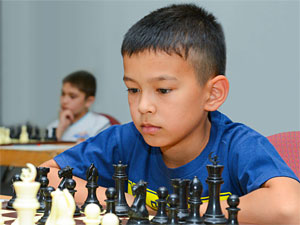Nodirbek Abdusattorov!
A few weeks ago while surfing some chess results, I stumbled on to a tournament played in Uzbekistan. I went through the results of the first round to see if there were any major upsets, and as I was about to move on, something caught my eye. I noticed that a very high-rated GM (exactly 2600) Andrei Zhigalko lost his first round to a 2057 FIDE rated player. This is of course a huge upset. But what makes it even more incredible is that the 2057 was a nine-year-old!
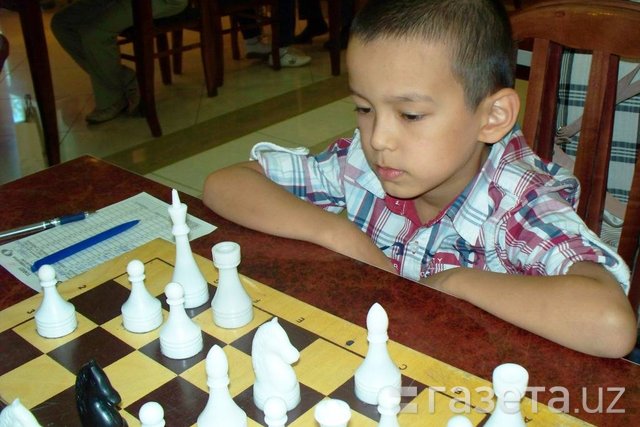
Abdusattorov previously won the Under-7 Asian Championship | Photo: Uzbekistan Chess Federation / gazeta.uz
That's right, nine-year-old FM Nodirbek Abdusattorov from Uzbekistan took down a 2600 GM. This was no fluke or a flippant move by the opponent turning into a major blunder. This was a gritty, square-by-square grind-down in which the youthful master prevailed.
The youngster then went on to overcome GM Ruslan Khusnutdinov in the same tournament, dispelling any doubts that the win against Zhigalko may have been a chance occurrence. Nodirbek is no stranger to high achievements: he won the gold medal in the U8 age category at World Youth Chess Championship in Maribor, Slovenia in 2012.
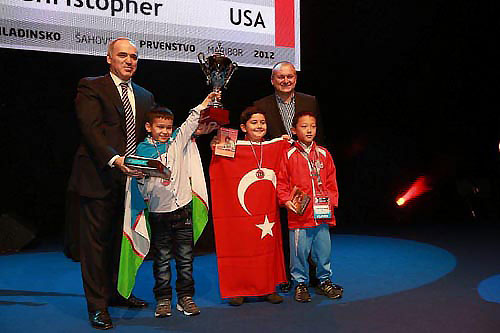
Nodirbek Abdusattorov won the gold medal at the World Youth Championship 2013
Well, grab some popcorn sit back, and marvel at the riveting game as Nordibek takes down the GM:

[Event "8th Agzamov Memorial 2014"] [Site "Tashkent UZB"] [Date "2014.05.15"] [Round "1.10"] [White "Abdusattorov, Nodirbek"] [Black "Zhigalko, A."] [Result "1-0"] [ECO "A08"] [WhiteElo "2057"] [BlackElo "2600"] [Annotator "Chandra,Akshat"] [PlyCount "135"] [EventDate "2014.05.15"] [EventRounds "9"] [EventCountry "UZB"] [Source "Mark Crowther"] [SourceDate "2014.05.19"] {It's the first round of the 8th Agzamov Memorial, and nine-year-old Nodirbek Abdusattorov finds himself playing a 2600 GM, Andrei Zhigalko, who is 550 points higher than him!} 1. e4 c5 2. Nf3 e6 3. d3 {An old favorite of Fischer's, who enjoyed good results with this move. White is aiming for a King's Indian setup with g3-Bg2-0-0.} (3. d4 {is of course the main move.}) 3... Nc6 4. g3 d5 5. Bg2 $2 {An opening inaccuracy, after which Black can reach a highly favorable endgame.} (5. Nbd2) ({or} 5. Qe2) 5... g6 $5 ({While 5...g6 is not a bad move, Black could have immediately taken advantage of White's imprecise move order by playing} 5... dxe4 6. dxe4 Qxd1+ 7. Kxd1 b6 { with the idea of either Ba6, or Bb7 followed by 0-0-0. By no means is it winning for Black, but it's very hard to come up with a constructive plan for White. However, perhaps Black didn't want to go to an endgame he wasn't sure he couldn't win, and decided to maintain the tension in the center.}) 6. O-O Bg7 7. c3 Nge7 8. Qc2 $5 {This is a bit unorthodox. The queen usually heads to e2.} (8. Qe2 {is the standard square for the queen in this line.}) 8... O-O 9. a4 {Restricting Black's queenside play, which begins with b5.} b6 10. Na3 {The knight seems to be a bit misplaced here, but Nbd2 Ba6, pressuring the d3 pawn would be annoying.} a6 11. Be3 h6 {I'm not sure what the point of this move is, but it shouldn't be too bad.} ({Continuing the development with} 11... Bb7 { [%cal Rd8d7,Ra8c8,Rf8d8] seems more natural.}) 12. Rad1 {Preparing to open up the center with d4, which would cause discomfort in Black's position.} d4 { Quite understandbly, Black prevents White from playing d4, by playing d4 himself!. This changes the pawn structure and releases the central tension, but it allows Black to develop more naturally.} (12... Bb7 {is playable for Black, but} 13. d4 {would be awkward to meet.}) 13. cxd4 cxd4 14. Bd2 e5 { Bolstering the center, but more importantly preparing the development of the bishop to e6, where it stands much better than it would be on b7.} 15. Nh4 $6 { Perhaps White wants to play f4, but that won't happen for a while, as we'll see. Black seems to ease into his development now, and I'm starting to prefer Zhigalko's position.} (15. b4 {seems quite reasonable, gaining some space on the Queenside and preparing an eventual Nc4.}) 15... Be6 16. Rc1 Rc8 17. Qd1 Na5 $1 {The knight prepares to hop into b3, where it would cause disarray in White's army.} 18. Bxa5 bxa5 19. Nc4 Nc6 ({By no means is the move played in the game bad, but} 19... Bxc4 {deserves some thought. It seems strange to isolate oneself with the "bad" g7 bishop, but this bishop is only temporarily bad. After} 20. Rxc4 Rxc4 21. dxc4 Nc6 {White is already facing some serious trouble. Black's next few moves are very logical, Qb6/Rb8 and the relocation of the f8 bishop to the f8-a3 diagonal, where it doesn't seem so bad at all!}) 20. Nf3 Rb8 21. Nfd2 h5 $2 {A common idea in which Black tries to relocate his bishop to h6, where it would apply pressure on the c1-h6 diagonal. However I feel that this gives White a target to chew on...} (21... Nb4 22. Qe2 Qd7 { [%csl Ra4][%cal Rd7a4] was another alternative, but perhaps Black was worried about} 23. f4 {after which the positions remains unbalanced. Black has nice queenside pressure, while White is stirring things up in the center and on the kingside.}) 22. f4 $1 {Usually when the pawn has been pushed to h5, the advance with f4-f5 can be quite difficult to deal with.} Bh6 23. f5 Bd7 {White develops a nagging edge now.} (23... Bxc4 {was the other alternative.} 24. Rxc4 Be3+ 25. Kh1 Nb4 26. Qe2 {The position seems roughly even, perhaps slightly favorable for Black, but I think that White's counterplay on the kingside compensates for his minor pieces, which are poorly placed if you compare them to their counterparts!}) 24. Qe2 Kh7 {The king seems worse on h7 then it was on g8, but it's already hard coming up with a constructive move/plan for Black. I'd say that the ball is in White's court now.} 25. Kh1 {White follows up with a king move of his own, but it doesn't really seem required at all!} ({The immediate} 25. Bh3 $16 {looks stronger. White can then follow up with Kg2, followed by a doubling of the rooks on the f-file.}) 25... h4 $2 {This creates new weaknesses.} ({Although not an easy decision, it was probably best to go back with} 25... Kg8 {and wait. Perhaps Black was still thinking about a win.}) 26. Bh3 hxg3 27. hxg3 g5 $2 {A horrifying positional move, which condemns Black's dark-squared bishop to eternal prison.} (27... Rh8 28. Kg2 Kg7 29. Bg4 Bg5 30. Rh1 Qe7 {seems like the best try. White still has to prove he has something here.}) 28. Kg2 {Preparing f6, Bg4 or Rh1! There are so many tempting possiblities for White...} f6 29. Bg4 {[%cal Rg4h5,Rh5g6] The once entombed bishop on g2 has now sprung to life, and is clearing the h-file for White's heavy artillery to infiltrate.} Kg7 30. Rh1 Rh8 31. Rh3 {[%cal Rc1h1]} Ne7 32. b3 {White's not trying to force matters, and is simply enjoying his position!} Be8 $2 {Now White crashes through.} (32... Kg8 {might have been the last chance, with the idea of playing Bg7 to try and trade of a pair of rooks, which will greatly diffuse White's attack. Of the top of the bat, I don't see a clear way to break through for White, but he should probably start with} 33. Bh5 {[%cal Rc4d6]} Qc7 {I fed this position into the computer, which just gives long forcing lines, not budging from the evaluation of 1.20. Perhaps this means that Black might be able to escape in the long run, although it will require some precise defense.}) 33. Bh5 Bc6 {Black basically just wasted a move, White was going to play Bh5 anyways.} 34. Qf3 ({White misses the immediate knockout with} 34. Nxe5 fxe5 35. f6+ $1 Kxf6 36. Qf3+ Ke6 (36... Kg7 37. Qf7#) 37. Nc4 Kd7 38. Qf6 {and Black's entire position crumbles. It is very possible both players were short on time here, and this is not an easy line to calculate.}) 34... Qd7 35. Nxe5 $1 {White doesn't miss his chance now.} Qxf5 (35... fxe5 36. f6+ Kg8 37. fxe7 Qxe7 38. Rxc6 $18) 36. Qxf5 (36. exf5 { was also winning.}) 36... Nxf5 37. Nxc6 g4 38. Bxg4 (38. Rhh1 {is the computer move, after which White retains the piece by force.} Bxd2 39. exf5 Bxc1 40. Nxb8 $18) 38... Bxd2 39. Bxf5 Bxc1 40. Nxb8 Rxb8 {The players have reached 40 moves, and Black has managed to create an oppositie colored bishop situation, but it won't be enough.} 41. Rh7+ Kg8 42. Rd7 Bb2 43. Be6+ Kh8 44. Kf3 Re8 45. Bc4 Re5 46. Rf7 Bc3 47. Rxf6 Kg7 48. Rxa6 Rg5 49. g4 Bd2 50. Rd6 Bc3 51. Rd7+ Kf6 52. Rf7+ Ke5 53. Re7+ Kf6 54. Re6+ Kf7 55. Re5+ Kf6 56. Rxg5 Kxg5 57. e5 Bb2 58. Be6 Kg6 59. Ke4 Kg7 60. Kd5 Kf8 61. g5 Kg7 62. Bf5 Bc1 63. g6 Be3 64. e6 Kf6 65. Kd6 Bd2 66. Kd7 Bb4 67. g7 Kxg7 68. e7 {A very impressive performance by Nodirbek!} 1-0
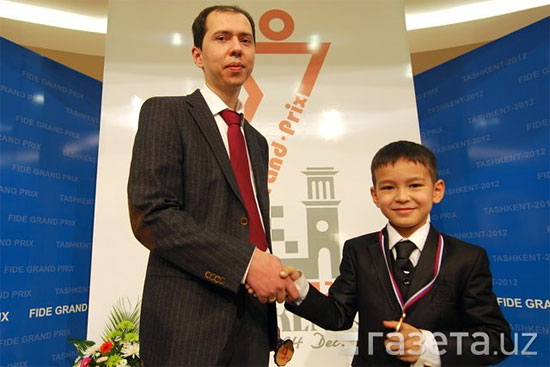
Nodirbek with his compatriot, former FIDE World Champion Rustam Kasimdzhanov | Photo: Gazeta.uz
Here is the unannotated second game of Nodirbek against GM Ruslan Khusnutdinov.

[Event "8th Agzamov Memorial 2014"] [Site "Tashkent UZB"] [Date "2014.05.17"] [Round "3.9"] [White "Abdusattorov, Nodirbek"] [Black "Khusnutdinov, R."] [Result "1-0"] [ECO "A04"] [WhiteElo "2057"] [BlackElo "2495"] [PlyCount "77"] [EventDate "2014.05.15"] [EventRounds "9"] [EventCountry "UZB"] [Source "Mark Crowther"] [SourceDate "2014.05.19"] 1. e4 c5 2. Nf3 e6 3. d3 Nc6 4. g3 Nge7 5. Bg2 g6 6. O-O Bg7 7. c3 e5 8. a3 O-O 9. b4 d6 10. Bb2 h6 11. Nbd2 Be6 12. b5 Nb8 13. c4 Nd7 14. Ne1 Qc7 15. Nc2 f5 16. exf5 gxf5 17. f4 Rf7 18. Qe2 Nf8 19. Rae1 Rd8 20. Ne3 Nfg6 21. Kh1 b6 22. a4 Kh7 23. Qh5 Bc8 24. Nd5 Nxd5 25. Bxd5 Bb7 26. Nf3 Rf6 27. Kg1 Bxd5 28. cxd5 Re8 29. fxe5 dxe5 30. Ng5+ Kg8 31. Ne4 Rff8 32. Rxf5 Rxf5 33. Qxf5 Nf8 34. Nf6+ Bxf6 35. Qxf6 Qf7 36. Qxh6 Qf5 37. Rf1 Qxd3 38. Bxe5 Qh7 39. Qg5+ 1-0
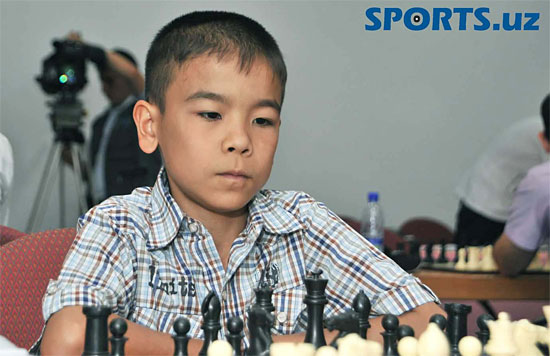
Shamsiddin Vokhidov | Photo: Sports.uz
I must note that in the same tournament another Uzbekistan youngster, Shamsiddin Vokhidov (above, photo Sports.uz), eleven years old, also had a great performance, beating Armenian GM Robert Hovhannisyan, rated 2613, who had tied first during the 2012 World Junior. Again a long, thoughtful game in which Shamsiddin emerged victorious.

[Event "8th Agzamov Memorial 2014"] [Site "Tashkent UZB"] [Date "2014.05.15"] [Round "1.9"] [White "Hovhannisyan, R."] [Black "Vokhidov, Shamsiddin"] [Result "0-1"] [ECO "A20"] [WhiteElo "2613"] [BlackElo "2063"] [PlyCount "146"] [EventDate "2014.05.15"] [EventRounds "9"] [EventCountry "UZB"] [Source "Mark Crowther"] [SourceDate "2014.05.19"] 1. c4 e5 2. d3 Nf6 3. Nf3 Nc6 4. a3 d5 5. cxd5 Nxd5 6. e3 g6 7. Nc3 Bg7 8. Bd2 O-O 9. Be2 b6 10. O-O Bb7 11. Rc1 a5 12. Qc2 Nde7 13. Rfd1 h6 14. Nb5 Qd7 15. Bc3 Nf5 16. e4 Nfd4 17. Nbxd4 exd4 18. Be1 Rac8 19. b4 axb4 20. axb4 f5 21. exf5 Qxf5 22. Nh4 Qg5 23. g3 Kh7 24. f4 Qf6 25. Bf3 Nd8 26. Be4 Bxe4 27. dxe4 Ne6 28. e5 Qf7 29. Qe4 c5 30. bxc5 Nxc5 31. Qb1 Bxe5 32. Qxb6 Nd7 33. Qb5 Bf6 34. Rxc8 Rxc8 35. Nf3 Rc5 36. Qd3 Rd5 37. Bb4 Qe6 38. Re1 Qc6 39. Be7 Bg7 40. Bb4 Bf6 41. Bd2 Qd6 42. Kg2 Qc6 43. h4 Kg7 44. g4 h5 45. g5 Bd8 46. Kg3 Nc5 47. Qe2 Qd7 48. Ne5 Qe6 49. Qf3 Qd6 50. Bb4 d3 51. Rd1 Bc7 52. Kg2 d2 53. Qe2 Qa6 54. Nc4 Ne6 55. Qe4 Nxf4+ 56. Kh1 Qc8 57. Qf3 Rd3 58. Bc3+ Kh7 59. Ne3 Rxc3 60. Rxd2 Qe8 61. Rc2 Rxc2 62. Nxc2 Qe2 63. Qxe2 Nxe2 64. Kg2 Be5 65. Nb4 Nd4 66. Nd3 Bd6 67. Nf2 Nf5 68. Kh3 Bg3 69. Ne4 Bxh4 70. Kg2 Kg7 71. Kf3 Nd4+ 72. Ke3 Ne6 73. Nd6 Bxg5+ 0-1
These emerging stars are raising the performance bar, and will continue to keep Uzbekistan in the chess news in the times ahead. If there are other youngsters that are doing incredibly well, please mention them in the 'Discuss' section below for our readers to follow. We will also keep an eye on them!
